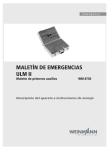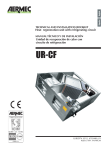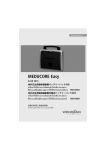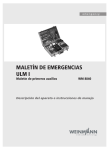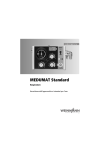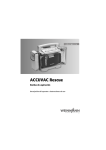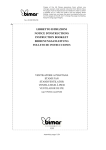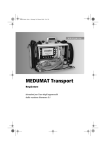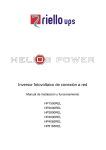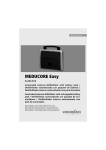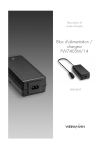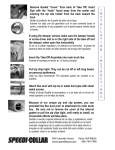Download LIFE-BASE 1 NG XS - WEINMANN Emergency
Transcript
LIFE-BASE 1 NG LIFE-BASE 1 NG XL LIFE-BASE 1 NG XS Portable system / Sistema de transporte Device description and instructions for use Descripción del aparato e instrucciones de manejo English 3 Español 34 Contents English 1. 1.1 1.2 1.3 1.4 1.5 2. 2.1 2.2 3. 3.1 4. 4.1 4.2 4.3 4.4 4.5 4.6 5. 5.1 5.2 5.3 5.4 6. 6.1 6.2 6.3 Overview . . . . . . . . . . . . . . . . . . . . 4 LIFE-BASE 1 NG/ LIFE-BASE 1 NG XL . . . . . . . . . . . . . 4 LIFE-BASE 1 NG XS . . . . . . . . . . . . 7 Wall mounting . . . . . . . . . . . . . . . 9 Special markings on the device . . 10 Safety information in these instructions . . . . . . . . . . . . . . . . . 11 Description of device . . . . . . . . . 12 Intended use. . . . . . . . . . . . . . . . 12 Description of function . . . . . . . 12 Safety instructions . . . . . . . . . . . 14 Safety information . . . . . . . . . . . 14 Assembly . . . . . . . . . . . . . . . . . . . 16 Wall mounting . . . . . . . . . . . . . . 16 Device (not mounted in the case of portable systems with an adapter plate) . . . . . . . . . . . . . . . . . . . . . . 16 Protective bag (LIFE-BASE 1 NG/ LIFE-BASE 1 NG XL) . . . . . . . . . . . 16 Protective bag (LIFE-BASE 1 NG XS) . . . . . . . . . . 17 Accessories bag (LIFE-BASE 1 NG/ LIFE-BASE 1 NG XL) . . . . . . . . . . . 19 LIFE-BASE 1 NG XS carrying strap 20 Operation . . . . . . . . . . . . . . . . . . 21 Hang portable system in wall mounting . . . . . . . . . . . . . . . . . . 21 Hang portable system from stretcher or hospital bed (LIFEBASE 1 NG/LIFE-BASE 1 NG XL) . . 22 Hang portable system from stretcher or hospital bed (LIFE-BASE 1 NG XS) . . . . . . . . . . 23 After use . . . . . . . . . . . . . . . . . . 23 Hygiene treatment . . . . . . . . . . . 24 Portable system . . . . . . . . . . . . . 24 Protective bag and accessories bag . . . . . . . . . . . . . . 24 Attached parts . . . . . . . . . . . . . . 25 7. 7.1 7.2 7.3 8. 8.1 9. 9.1 9.2 9.3 10. Function check . . . . . . . . . . . . . . . Visual inspection. . . . . . . . . . . . . Check catch . . . . . . . . . . . . . . . . Check protective bag (if present) Servicing . . . . . . . . . . . . . . . . . . . . Disposal . . . . . . . . . . . . . . . . . . . Scope of supply . . . . . . . . . . . . . . General information . . . . . . . . . . Standard scope of supply . . . . . . Accessories and spare parts . . . . Technical data . . . . . . . . . . . . . . . 11. Warranty . . . . . . . . . . . . . . . . . . . . 31 12. Declaration of conformity . . . . . 32 Contents EN 26 26 26 26 27 27 28 28 28 29 30 3 1. Overview 1.1 LIFE-BASE 1 NG/LIFE-BASE 1 NG XL LIFE-BASE 1 NG 4 Push-button 5 Handle 6 Lug for strap 3 Knurled screw 2 Hanger 1 Portable system LIFE-BASE 1 NG XL 5 Handle 4 Push-button 3 Knurled screw 6 Lug for strap 1 Portable system 2 Hanger 7 Adapter plate Key 1 Portable system 2 Hanger The portable system is for storing a combination of ventilation and therapy devices and the necessary components. The hanger is for hanging the portable system from a hospital bed or stretcher. 3 Knurled screw The knurled screw is for fixing the hanger in position. 4 EN Overview 4 Push-button 6 Lug for strap The push-buttons are used to fix the protective bag to the portable system. The strap for the portable system can be attached to this lug. 5 Handle 7 Adapter plate Use the handle to lift and carry the portable system. The devices can be attached to the portable system with the aid of the adapter plate. Overview EN 5 Protective bag Rear view LIFE-BASE 1 NG 1 4 5 6 7 8 2 9 3 Rear view LIFE-BASE 1 NG XL 4 1 10 3 Key 1 Cable duct for charger interface 5 Side access compartment 2 Vibration dampers (only with MEDUMAT Transport) 6 Viewing window 3 Hinge for bottom rail 4 Push-button to fix protective bag in position 7 Velcro tab to access the control panel 8 Reflective strip 9 Opening for passing through a patient tube system 10 Adapter plate 6 EN Overview 1.2 LIFE-BASE 1 NG XS Rear view Front view 4 Handle 5 Charger interface 6 Lug for tensioning belt (long) 3 Lug for tensioning belt (short) 2 Adapter plate 1 Portable system 7 Hinge for bottom rail Protective bag for ventilator Protective bag for defibrillator 8 Viewing window 9 Reflective strip 10 Side compartment 11 Velcro tape (with ventilator only) 12 Loop for Velcro tape (with ventilator only) Carrying strap 13 Carrying strap Tensioning belts 14 Tensioning belt (short) 15 Tensioning belt (long) Overview EN 7 1 Portable system 10 Side compartment The portable system is for storing a device and its components. You can store the components and accessories of the device in the side compartments. With the ventilator, the left-hand side compartment provides access to the compressed gas connection and space for the pressure tube, and the righthand side compartment provides access to the device inlet filter. With the defibrillator, the lefthand side compartment provides access to the rechargeable battery, and the right-hand side compartment provides space for components such as cables, for example. 2 Adapter plate You can use the adapter plate to attach the device to the portable system. 3 Lug for tensioning belt (short) You can attach a tensioning belt (short) to this lug. 4 Handle The portable system can be lifted and carried by the handle. You can attach the carrying strap to the handle. 5 Charger interface You can charge the device on the portable system using the charger interface. 11 Velcro tape (with ventilator only) The Velcro tapes are used to attach the patient tube system to the protective bag. 12 Loop for Velcro tape (with ventilator only) 6 Lug for tensioning belt (long) The Velcro tapes can be attached to these loops which hold the patient tube system. You can attach a tensioning belt (long) to this lug. 13 Carrying strap 7 Hinge for bottom rail You can use the carrying strap to carry the portable system on your shoulder. This hinge is used to hang the portable system in the wall mounting. 8 Viewing window This is where to read off the device display when the protective bag is closed. 9 Reflective strip The reflective strip means the protective bag is also visible in the dark. 8 EN Overview 14 Tensioning belt (short) The tensioning belt holds the pressure tube of the ventilator if you are not using a protective bag. 15 Tensioning belt (long) The tensioning belt holds the patient tube system of the ventilator if you are not using a protective bag. 1.3 Wall mounting BASE-STATION 1 NG Catch for wall mounting 6 Control pin 1 Catch 2 Bore 3 Guide pin 4 Charger interface 8 Catch cross-bar 7 Catch housing 5 Bottom rail BASE-STATION Mini II 1 Catch 2 Bore 3 Guide pin 4 Charger interface 5 Bottom rail 1 Catch 6 Control pin 2 Bore 7 Catch housing 3 Guide pin 8 Catch cross-bar 4 Charger interface 5 Bottom rail Overview EN 9 1.4 Special markings on the device 1 2 3 4 Markings on the portable system No. Symbol Significance Information plate for portable system 1 Year of manufacture SN Serial number of portable system CE symbol (confirms that the product conforms to applicable European directives) Portable system 2 Do not dispose of the portable system in domestic waste. Markings on the wall mounting No. Symbol Significance Information plate for wall mounting 3 Year of manufacture SN Serial number of wall mounting Do not dispose of the wall mounting with domestic waste. Wall mounting 4 10 EN Overview Shows how the catch unlatches and the portable system is removed from the wall mounting. Markings on the carrying strap Symbol Significance Do not iron Wash at 30 °C Do not dry in a tumble-dryer Follow instructions for use Maximum load Markings on the packaging Symbol 4 rh % 0-95 Significance Permitted temperature for storage: -40 °C to +70 °C Permitted humidity for storage: max. 95 % relative humidity 1.5 Safety information in these instructions Safety information in these instructions for use is marked as follows: Warning! Warns of risk of injury and potential material damage. Caution! Warns of material damage and potentially false therapy results. Note Contains useful tips. Overview EN 11 2. Description of device 2.1 Intended use The portable system is for storing a combination of devices from the MEDUMAT, MODUL and MEDUCORE series, together with the required components (charger interface, tubes, accessories bag, protective bag and electrical cables). This provides a user with mobile units for treating respiratory disorders, for monitoring cardiovascular parameters and for resuscitation support. The portable system can be latched in the associated BASE-STATION 1 NG and BASE-STATION Mini II wall mountings to fix it securely to the wall. The BASE-STATION 1 NG can be attached to various retaining devices in emergency vehicles and in hospitals using a variety of attachment sets. 2.2 Description of function All the devices provided are securely mounted on the portable system, making them easier for you to transport and operate. Using the hangers, you can hang the portable system from a stretcher, a hospital bed or a standard hospital rail. The portable system can be secured in a hospital environment or in an emergency vehicle in conjunction with the BASE-STATION 1 NG or BASE-STATION Mini II wall mounting (see “9.3 Accessories and spare parts” on page 29). The portable system can also be secured to the ceiling in conjunction with the BASE-STATION 1 NG roof mounting. The BASE-STATION 1 NG and BASE-STATION Mini II wall mountings are assembled for fixing to the wall. You can also expand them by adding the following attachment sets: 12 • attachment set for standard hospital rail (BASE-STATION 1 NG and BASE-STATION Mini II): attach the wall mounting to a standard hospital rail in vehicles or in hospital. • attachment set for fitting to a rail (BASE-STATION 1 NG): attach the wall mounting to a rail (Ø 19 mm - 38 mm) in hospital. The rail can be horizontally or vertically aligned. EN Description of device • supplementary attachment set for standard hospital rail (BASE-STATION Mini II): for attaching the wall mounting to a standard hospital rail in vehicles You can remove the portable system from the wall mounting in just one maneuver. Description of device EN 13 3. Safety instructions 3.1 Safety information Read these instructions for use carefully. It is a component part of the following portable systems: – LIFE-BASE 1 NG – LIFE-BASE 1 NG XL – LIFE-BASE 1 NG XS The instructions for use must be available at all times. Use the portable system exclusively for the intended purpose described (see “2.1 Intended use” on page 12). For your own safety and the safety of your patients and in accordance with the requirements of Directive 93/42/EEC, please note the following. Use of the portable system Warning! Use the portable system only if you are medically trained and have received instruction in ventilation/aspiration. Severe physical damage may be caused by incorrect use. Caution! • Before working with the portable system, you must have understood how to use it. • To avoid infection or bacterial contamination, follow the section entitled “6. Hygiene treatment” on page 24. • Do not use the portable system in the vicinity of a magnetic resonance tomography (MRT) device. • Use the portable system only for the intended use described (see “2.1 Intended use” on page 12). • During the journey/flight, the portable system must be hung in the wall mounting intended for it, as otherwise it might fall over or be thrown around the vehicle. The wall mounting must be securely attached. Follow the fitting instructions for the wall mounting and the attachment set in question. • Note that the portable system may not be loaded with an additional weight, e.g. 14 EN Safety instructions be leant on by a person, even once it is fixed in position. The portable system may fall down and injure people or the device may be damaged. Use of the wall mounting Warning! • Only the portable systems LIFE-BASE 1 NG, LIFE-BASE 1 NG XL, LIFE-BASE 1 NG XS and LIFE-BASE Mini II should be suspended in the BASE-STATION 1 NG and BASE-STATION Mini II wall mountings. The weight and dimensions of these portable systems are exactly matched to the wall mountings. • Hanging third-party products or adapters from other manufacturers is not permitted, as this does not comply with the use in accordance with purpose of this wall mounting. Accessories/replacement parts Caution! If third-party items are used, functional failures may occur and fitness for use may be restricted. Biocompatibility requirements may also not be met. Please note that in such cases, any claim under warranty and liability will be voided if neither the accessories nor genuine replacement parts recommended in the instructions for use are used. Maintenance Caution! Have servicing and maintenance work carried out only by the manufacturer, WEINMANN Emergency, or by trained staff. Safety instructions EN 15 4. Assembly 4.1 Wall mounting The wall mounting for the portable system is ready for fitting to a wall. Using a suitable attachment set (see Section 9.3 on page 29), you can also fit the wall mounting to a standard hospital rail or an ordinary rail (Ø 19 mm - 38 mm). When fitting, follow the relevant fitting instructions enclosed with the wall mounting and the attachment sets in question. 4.2 Device (not mounted in the case of portable systems with an adapter plate) Note: In most cases, the device is already mounted on the portable system. You only need to mount the device if you order a device separately. 1. Unscrew the adapter plate from the portable system. 2. Screw the adapter plate onto the rear of the device. 3. Screw the adapter plate and the device to the portable system. 4.3 Protective bag (LIFE-BASE 1 NG/ LIFE-BASE 1 NG XL) Attach protective bag 1. Place the protective bag on a firm, level surface. 2. Place the portable system inside, on the base of the protective bag. 3. Attach the protective bag to the portable system using the push-buttons. 16 EN Assembly 4. If there is a ventilator on the portable system: Route the patient tube system through the front opening in the protective bag. 5. Close the velcro tabs on the front and rear. Remove protective bag 1. Place the portable system on a firm, level surface. 2. Open the Velcro tabs on the front. 3. Open the push-buttons on the portable system and remove the portable system from the protective bag from the rear. 4.4 Protective bag (LIFE-BASE 1 NG XS) 1. Place the portable system on a firm, level surface. 2. Remove all the device components. 3. On the ventilator: push the underside of the protective bag into the space between the portable system and the ventilator from the front and pull the top of the protective bag over the portable system as far as the handle. Alternatively on the defibrillator: push the protective bag over the portable system from the front. Assembly EN 17 4. Close the Velcro tab on the rear of the portable system. 5. Place the protective bag around the handle and close the Velcro tabs under and next to the handle. 6. Connect all components to the device. 7. On the defibrillator: stow the electrodes under the defibrillator. 8. Close the viewing window of the protective bag. 9. On the ventilator: clamp the patient tube system in the space between the portable system and the ventilator and fix it in position with the Velcro tabs on the protective bag. 10.Stow the accessories and small parts in the side compartments of the protective bag Remove protective bag 1. Place the portable system on a firm, level surface. 2. On the ventilator: open the Velcro tapes on the patient tube system and pull it out of the space between the portable system and the ventilator. 3. On the ventilator: open the viewing window of the protective bag. 4. On the ventilator: detach the patient tube system. 5. Open the Velcro tab on the rear of the portable system. 18 EN Assembly 6. Take the portable system out of the protective bag backwards. 4.5 Accessories bag (LIFE-BASE 1 NG/ LIFE-BASE 1 NG XL) There are four types of accessories bag: – accessories bag for ventilators (fitted on the side) – accessories bag for defibrillation/ventilation (fitted on the side) – accessories bag for defibrillation (fitted on the portable system) Fit accessories bag for ventilators 1. Open the Velcro tabs on the rear of the accessories bag. 2. Pass the Velcro tabs through the loops on the protective bag. 3. Close the Velcro tabs on the rear of the accessories bag. Assembly EN 19 Fit accessories bag for defibrillation/ventilation 1. Hook the zip on the accessories bag into the zip on the protective bag. 2. Close the zip. Note The accessories bag for defibrillation is attached to the left of the protective bag, the accessories bag for ventilation to the right of the protective bag. Fit accessories bag for defibrillation 1. Press the accessories bag against the rear wall of the portable system. 4.6 LIFE-BASE 1 NG XS carrying strap 1. Place the Velcro tab of the carrying strap around the handle and close it. 20 EN Assembly 5. Operation 5.1 Hang portable system in wall mounting Hang portable system Note If you are using a protective bag, ensure that the protective bag is properly located first. 1. To hang the portable system in the wall mounting, place the portable system in the bottom rail. Bottom rail Warning! – Risk of injury from loose portable system! An inadequately secured portable system may fall off or be thrown around the vehicle. Control pin – Ensure that you both hear and feel the catch engage. Catch cross-bar Catch housing – Check that the red control pin is flush with the top edge of the catch housing and does not protrude. 2. Swivel the portable system towards the wall until you hear and feel the catch cross-bar engage. Operation EN 21 Remove portable system 1. For unlatching, it is essential to grasp through the handle so that the portable system does not fall out of the wall mounting and injure someone. 2. To unlatch, push the catch cross-bar upwards. 3. Swivel the portable system forwards a little way and lift the portable system up off the bottom rail. 5.2 Hang portable system from stretcher or hospital bed (LIFE-BASE 1 NG/ LIFE-BASE 1 NG XL) You can also hang the portable system from a stretcher or a hospital bed, as long as the rail diameter does not exceed 35 mm. Caution! Note that the portable system may not be loaded with an additional weight, e.g. be leant on by a person, even once it is fixed in position. The portable system may fall down and injure people or the device may be damaged. 1. Undo the knurled screws. 2. Extend the hanger the required distance. 3. Tighten the knurled screws back up. 4. Hang the portable system from a stretcher, a hospital bed or a standard rail. Note The portable system can only be hung back on a wall mounting once you have pushed the hanger back into its original position. 22 EN Operation 5.3 Hang portable system from stretcher or hospital bed (LIFE-BASE 1 NG XS) You can only hang the portable system from a stretcher or a hospital bed if you use a protective bag. Caution! Note that the portable system may not be loaded with an additional weight, e.g. be leant on by a person, even once it is fixed in position. The portable system may fall down and injure people or the device may be damaged. 1. Open the magnetic closures on the straps on the rear of the protective bag sideways. 2. Guide the straps round a rail of the stretcher or hospital bed. 3. Close the magnetic closures. 5.4 After use 1. Open the protective bag (if present). 2. If present: Remove the pressure tube of the oxygen supply or stow it in the side compartment of the protective bag. 3. If present: Remove the patient tube system. 4. Close the protective bag again (if present). Operation EN 23 6. Hygiene treatment The portable system must be cleaned and disinfected after every use. Always perform a function check afterwards (see “7. Function check” on page 26). 6.1 Portable system The portable system is cleaned without its devices by the scouring and wiping method. You can take all the devices off the portable system for this purpose. • See the instructions for use for the disinfectant used. • For disinfecting by wiping, we recommend terralin® protect. • We recommend wearing suitable gloves (e.g. household or disposable gloves) for disinfecting. Note For further information on hygiene treatment and a list of all cleaning agents and disinfectants which can be used, please see our Internet brochure at www.weinmann-emergency.de. 6.2 Protective bag and accessories bag Subject the bags to hygiene treatment in accordance with the table below: Bag Cleaning PVC protective bag In hot water with a mild PVC accessories bag detergent CORDURA® protective bag CORDURA® accessories bag In hot water with a mild detergent Alternatively: 30 °C cycle in a washing machine, no spin Disinfecting Sterilizing Disinfectant wipe Not permitted 30 °C cycle in a washing machine (no spin), using a suitable disinfecting additive (disinfecting detergent or impregnation agent) Not permitted Note: To prevent unattractive washing powder deposits, we recommend using a liquid detergent. 24 EN Hygiene treatment 6.3 Attached parts Follow the instructions for cleaning, disinfecting and, if appropriate, sterilizing in the associated instructions for use. Hygiene treatment EN 25 7. Function check You must subject the portable system to a function check before it is used each time and every time it has been dismantled, but in any case at least every 6 months. If you discover faults during the function check, you may not use the portable system again until the faults have been rectified. To guarantee that the portable system works perfectly, observe the following points. 7.1 Visual inspection Look at the portable system closely. The portable system may not be damaged in any way – which could result in parts coming loose – which may restrict its function or – which may cause injuries. If you find any damage relating to one of these points, the portable system must be repaired or replaced. 7.2 Check catch 1. Hang the portable system in the wall mounting and allow it to engage. – The portable system must be located firmly in the wall mounting. – The red control pin of the catch cross-bar must be flush with the top edge of the catch housing. 2. Check unlatching next. To do this, reach through the handle and pull the catch crossbar upwards. – The catch cross-bar must be easy to move. – The portable system may not catch on removal. 7.3 Check protective bag (if present) Check push-buttons Open and close the push-buttons. – The push-buttons may not pop open again. 26 EN Function check Check Velcro tabs Open the Velcro tabs. – Both types of tape should be free of contamination. Check magnetic closures Open and close the magnetic closures. – The magnetic closures may not pop open again. 8. Servicing The portable system and the wall mounting require no servicing, but observe the intervals for regular function checks on the attached parts. Look these up in the associated instructions for use if appropriate. We recommend having maintenance measures such as servicing and repair work carried out by the manufacturer, WEINMANN Emergency, or by specialist staff. 8.1 Disposal LIFE-BASE 1 NG without charger interface BASE-STATION 1 NG without charger interface BASE-STATION Mini II without charger interface Do not dispose of the device in domestic waste. To dispose of the device properly, contact a licensed, certified disposal company. You can find an address from your environment officer or from your municipal authorities. The device packaging (cardboard and inserts) can be disposed of in paper recycling facilities. LIFE-BASE 1 NG/LIFE-BASE 1 NG XL/LIFE-BASE 1 NG XS with charger interface BASE-STATION 1 NG with charger interface BASE-STATION Mini II with charger interface Do not dispose of the device in domestic waste. To dispose of the device properly, contact a licensed, certified electronic scrap disposal merchant. You can find an address from your environment officer or from your municipal authorities. The device packaging (cardboard and inserts) can be disposed of in paper recycling facilities. Servicing EN 27 9. Scope of supply 9.1 General information The following applies to the portable system • The portable system is supplied fully assembled depending on the equipment variant. • Each portable system is supplied with these instructions for use. The BASE-STATION 1 NG and BASE-STATION Mini II wall mountings are not included in the scope of supply and should be ordered separately if required (see “9.3 Accessories and spare parts” on page 29). 9.2 Standard scope of supply Description Order no. LIFE-BASE 1 NG without charger interface and MEDUMAT Transport without CO2 measurement WM 9630 MEDUMAT Transport with CO2 measurement WM 9635 LIFE-BASE 1 NG with charger interface and MEDUMAT Transport without CO2 measurement WM 9620 MEDUMAT Transport with CO2 measurement WM 9625 LIFE-BASE 1 NG XL with charger interface and MEDUCORE Standard Advanced WM 9720 MEDUCORE Standard Advanced plus MEDUMAT Easy CPR WM 9725 MEDUCORE Standard Advanced plus MEDUMAT Standard a WM 9730 MEDUCORE Standard Pro WM 9755 MEDUCORE Standard Pro plus MEDUMAT Easy CPR WM 9760 MEDUCORE Standard Pro plus MEDUMAT Standard a WM 9765 MEDUCORE Standard Basic WM 9735 28 EN Scope of supply Description Order no. MEDUCORE Standard Basic plus MEDUMAT Easy CPR WM 9740 MEDUCORE Standard Basic plus MEDUMAT Standard a WM 9745 MEDUMAT Standard2 WM 9400 2 WM 9405 MEDUMAT Standard plus MEDUCORE Standard LIFE-BASE 1 NG XS with charger interface and 2 MEDUMAT Standard WM 9870 MEDUCORE Standard Basic WM 9882 MEDUCORE Standard Advanced WM 9883 MEDUCORE Standard Pro WM 9880 9.3 Accessories and spare parts You can order accessories and spare parts separately if required. A current list of accessories and spare parts can be ordered on the Internet at www.weinmann-emergency.de or via your dealer. Scope of supply EN 29 10. Technical data LIFE-BASE 1 NG Product class to 93/42/EEC Class I Standards applied EN 1789 Dimensions (without protective bag) W x H x D in mm 415 x 240 x 140 (LIFE-BASE 1 NG) 427 x 240 x 140 (LIFE-BASE 1 NG XL) 220 x 230 x 136 (LIFE-BASE 1 NG XS) Weight Empty: LIFE-BASE 1 NG: approx. 2.0 kg LIFE-BASE 1 NG XL: approx. 2.2 kg LIFE-BASE 1 NG XS: approx. 1.0 kg With equipment: LIFE-BASE 1 NG and LIFE-BASE 1 NG XL: max. 7.0 kg LIFE-BASE 1 NG XS: max. 5.0 kg Maximum load for carrying strap 5 kg Temperature range – operation – storage –18 °C to +60 °C –40 °C to +70 °C Note The temperature range may be limited by any devices fitted! Electrical rating for charger interface 12 V DC, Imax = 8 A The right to make design modifications is reserved 30 EN Technical data 11. Warranty WEINMANN Emergency gives the customer a limited manufacturer warranty on new genuine WEINMANN Emergency products and any replacement part fitted by WEINMANN Emergency in accordance with the warranty conditions applicable to the product in question and in accordance with the warranty periods from date of purchase as listed below. The warranty conditions can be downloaded from www.weinmann-emergency.de on the Internet. We can also send you the warranty conditions on request. In the event of a claim under warranty, contact your specialist dealer. Product Warranty period WEINMANN Emergency devices including accessories (exception: masks) for oxygen 2 years and emergency medicine Masks including accessories, rechargeable battery, batteries (unless there is information to the contrary in the 6 months technical documentation), sensors, tube systems Disposable products None Warranty EN 31 12. Declaration of conformity WEINMANN Emergency Medical Technology GmbH + Co. KG declares herewith that the product complies fully with the respective regulations of the Medical Device Directive 93/42/ EEC. The unabridged text of the Declaration of Conformity can be found on our website at www.weinmann-emergency.de 32 EN Declaration of conformity Indice Español 1. 1.1 1.2 1.3 1.4 1.5 2. 2.1 2.2 3. 3.1 4. 4.1 4.2 4.3 4.4 4.5 4.6 5. 5.1 5.2 5.3 5.4 Vista general . . . . . . . . . . . . . . . . 34 LIFE-BASE 1 NG/ LIFE-BASE 1 NG XL . . . . . . . . . . . . 34 LIFE-BASE 1 NG XS . . . . . . . . . . . 37 Soporte mural. . . . . . . . . . . . . . . 39 Señalización especial en el aparato . . . . . . . . . . . . . . . . . . . . 40 Indicaciones de seguridad en estas instrucciones . . . . . . . . . . . . 41 Descripción del aparato . . . . . . . 42 Uso conforme a lo dispuesto. . . . 42 Descripción del funcionamiento . 42 Indicaciones de seguridad . . . . . 44 Disposiciones de seguridad . . . . . 44 Montaje . . . . . . . . . . . . . . . . . . . . 46 Soporte mural. . . . . . . . . . . . . . . 46 Aparato (sin montar, para sistemas de transporte con placa adaptadora) . . . . . . . . . . . . . . . . . 46 Bolsa de protección (LIFE-BASE 1 NG/ LIFE-BASE 1 NG XL) . . . . . . . . . . . 47 Bolsa de protección (LIFE-BASE 1 NG XS) . . . . . . . . . . 47 Bolsa de accesorios (LIFE-BASE 1 NG/ LIFE-BASE 1 NG XL) . . . . . . . . . . . 49 Correa LIFE-BASE 1 NG XS . . . . . 50 Manejo . . . . . . . . . . . . . . . . . . . . . 51 Enganchar el sistema de transporte en el soporte mural . . . 51 Enganchar el sistema de transporte a la camilla o la cama de hospital (LIFE-BASE 1 NG/ LIFE-BASE 1 NG XL) . . . . . . . . . . . 52 Enganchar el sistema de transporte a la camilla o la cama de hospital (LIFE-BASE 1 NG XS) . . . . . . . . . . 53 Después del uso . . . . . . . . . . . . . 53 6. 6.1 6.2 8. 8.1 9. 9.1 9.2 9.3 10. Acondicionamiento higiénico . . . 54 Sistema de transporte . . . . . . . . . 54 Bolsa de protección y bolsa de accesorios . . . . . . . . . . . . . . . . . . 55 Piezas montables . . . . . . . . . . . . 55 Control del funcionamiento . . . . 56 Control visual . . . . . . . . . . . . . . . 56 Comprobar el enclavamiento . . . 56 Comprobar la bolsa de protección (si dispone de ella) . . . 57 Mantenimiento . . . . . . . . . . . . . . 58 Eliminación . . . . . . . . . . . . . . . . . 58 Volumen de suministro . . . . . . . . 59 Indicaciones generales . . . . . . . . 59 Volumen de suministro de serie . 59 Accesorios y piezas de repuesto . 60 Datos técnicos . . . . . . . . . . . . . . . 61 11. Garantía . . . . . . . . . . . . . . . . . . . . 62 12. Declaración de conformidad . . . 63 6.3 7. 7.1 7.2 7.3 Indice ES 33 1. Vista general 1.1 LIFE-BASE 1 NG/LIFE-BASE 1 NG XL LIFE-BASE 1 NG 4 Botón a presión 5 Asa de transporte 6 Ojal para correa 3 Tornillo moleteado 2 Ángulo de sujeción 1 Sistema de transporte 5 Asa de transporte 4 Botón a presión 3 Tornillo moleteado LIFE-BASE 1 NG XL 6 Ojal para correa 1 Sistema de transporte 2 Ángulo de sujeción 7 Placa adaptadora Leyenda 1 Sistema de transporte 2 Ángulo de sujeción El sistema de transporte sirve para el alojamiento de una combinación de aparatos de respiración artificial y de terapia, así como los componentes necesarios. El ángulo de sujeción sirve para enganchar el sistema de transporte en una cama de hospital o una camilla. 3 Tornillo moleteado El tornillo moleteado sirve para fijar el ángulo de sujeción. 34 ES Vista general 4 Botón a presión 6 Ojal para correa Con los botones a presión puede fijar la bolsa de protección al sistema de transporte. En este ojal puede fijar la correa para el sistema de transporte. 5 Asa de transporte 7 Placa adaptadora Con el asa de transporte puede levantar y llevar el sistema de transporte. Los aparatos pueden fijarse al sistema de transporte con la ayuda de la placa adaptadora. Vista general ES 35 Bolsa de protección Vista posterior LIFE-BASE 1 NG 5 1 4 6 7 8 2 3 9 Vista posterior LIFE-BASE 1 NG XL 4 1 10 3 Leyenda 1 Paso de cable para la interfaz de carga 5 Compartimento de acceso lateral 2 Amortiguadores (exclusivamente en MEDUMAT Transport) 6 Mirilla 3 Eje para la guía de asiento inferior 4 Botón a presión para fijar la bolsa de protección 7 Cierre de velcro para abrir el panel de mando frontal 8 Tiras reflectantes 9 Orificio para el paso de un sistema de mangueras para pacientes 10 Placa adaptadora 36 ES Vista general 1.2 LIFE-BASE 1 NG XS Vista posterior Vista frontal 4 Asa de transporte 5 Interfaz de carga 6 Ojal para la correa tensora (larga) 3 Ojal para la correa tensora (corta) 2 Placa adaptadora 1 Sistema de transporte 7 Eje para el riel de sujeción inferior Bolsa de protección para el desfibrilador 8 Mirilla Bolsa de protección para el aparato de respiración artificial 9 Tiras reflectantes 10 Compartimento lateral 11 Cinta de velcro (sólo en el aparato de respiración artificial) 12 Lazo para la cinta de velcro (sólo en el aparato de respiración artificial) Correa 13 Correa Correa tensora 14 Correa tensora (corta) 15 Correa tensora (larga) Vista general ES 37 1 Sistema de transporte 10 Compartimento lateral El sistema de transporte sirve para alojar un aparato y sus componentes. Puede almacenar los componentes y accesorios del aparato en los compartimentos laterales. Para el aparato de respiración artificial, el compartimento de la izquierda permite acceder a la conexión de gas a presión y ofrece espacio para el tubo de presión, y el compartimento de la derecha permite acceder a la batería y al filtro de entrada del aparato. Para el desfibrilador, el compartimento de la izquierda permite acceder a la batería y el compartimento de la derecha ofrece espacio para los componentes, como p.ej. cables. 2 Placa adaptadora Puede fijar el aparato al sistema de transporte con la ayuda de la placa adaptadora. 3 Ojal para la correa tensora (corta) Puede fijar a este ojal la correa tensora (corta). 4 Asa de transporte Con el asa de transporte puede levantar y llevar el sistema de transporte. Puede fijar la correa al asa de transporte. 5 Interfaz de carga Con la interfaz de carga, puede cargar el aparato en el sistema de transporte. 6 Ojal para la correa tensora (larga) Puede fijar a este ojal la correa tensora (larga). 7 Eje para el riel de sujeción inferior Este eje sirve para colgar el sistema de transporte en el soporte mural. 11 Cinta de velcro (sólo en el aparato de respiración artificial) Las cintas de velcro fijan el sistema de tubos flexibles para el paciente a la bolsa de protección. 12 Lazo para la cinta de velcro (sólo en el aparato de respiración artificial) Las cintas de velcro que sujetan el sistema de tubos flexibles para el paciente pueden fijarse a estos lazos. 13 Correa 8 Mirilla Con la correa puede llevar el sistema de transporte al hombro. Le permite leer la pantalla del dispositivo con la bolsa de protección cerrada. 14 Correa tensora (corta) 9 Tiras reflectantes La bolsa de protección tiene tiras reflectantes visibles en la oscuridad. La correa tensora sujeta el tubo de presión del aparato de respiración artificial, en caso de que no utilice una bolsa de protección. 15 Correa tensora (larga) La correa tensora sujeta el sistema de tubos flexibles para el paciente del aparato de respiración artificial, en caso de que no utilice una bolsa de protección. 38 ES Vista general 1.3 Soporte mural BASE-STATION 1 NG Bloqueo soporte mural 6 Pasador de control 1 Bloqueo 2 Agujero 3 Pasador de guía 4 Interfaz de carga 5 Guía de asiento inferior 8 Eje de enclavamiento 7 Carcasa de enclavamiento BASE-STATION Mini II 1 Bloqueo 2 Agujero 3 Pasador de guía 4 Interfaz de carga 5 Guía de asiento inferior 1 Bloqueo 6 Pasador de control 2 Agujero 7 Carcasa de enclavamiento 3 Pasador de guía 8 Eje de enclavamiento 4 Interfaz de carga 5 Guía de asiento inferior Vista general ES 39 1.4 Señalización especial en el aparato 1 2 3 4 Señalización en el sistema de transporte N.º Símbolo Significado Letrero del aparato, sistema de transporte 1 Año de fabricación SN Número de serie del sistema de transporte Marca CE (confirma que el producto cumple las directivas europeas vigentes) Sistema de transporte 2 No elimine el sistema de transporte tirándolo a la basura doméstica. Señalización en el soporte mural N.º Símbolo Significado Letrero del aparato, soporte mural 3 Año de fabricación SN Número de serie del soporte mural No elimine el soporte mural tirándolo a la basura doméstica. Soporte mural 4 40 ES Vista general Indica cómo puede liberar el enclavamiento y desprender el sistema de transporte del soporte mural. Indicaciones en la correa Símbolo Significado No planchar Lavar a 30 ºC No secar en secadora Tener en cuenta el manual de instrucciones Carga máxima Señalización en el embalaje Símbolo 4 de hum. rel. % 0-95 Significado Temperatura admisible de almacenamiento: - 40 °C a +70 °C Humedad atmosférica admisible de almacenamiento: 95 % máximo de humedad relativa 1.5 Indicaciones de seguridad en estas instrucciones En este manual de instrucciones se señalizan las indicaciones de seguridad de la siguiente forma: ¡Advertencia! Advierte de la existencia de peligro de lesiones y posibles daños materiales. ¡Precaución! Advierte de daños materiales y posiblemente de resultados de terapia incorrectos. Nota: Contiene consejos útiles. Vista general ES 41 2. Descripción del aparato 2.1 Uso conforme a lo dispuesto El sistema de transporte sirve para alojar una combinación de aparatos de las series MEDUMAT, MODUL y MEDUCORE, así como los componentes necesarios (interfaz de carga, tubos, bolsa de accesorios y de protección, cables eléctricos). De este modo, el usuario dispone de unidades móviles para el tratamiento de trastornos respiratorios, el seguimiento de los parámetros cardiovasculares y de asistencia en la reanimación. Para una fijación segura, el sistema de transporte se puede enclavar en los soportes murales correspondientes BASE-STATION 1 NG y BASE-STATION Mini II. Mediante diversos juegos de montaje, la BASE-STATION 1 NG se puede montar en diferentes dispositivos de soporte en los medios de salvamento y en el ámbito hospitalario. 2.2 Descripción del funcionamiento Todos los aparatos previstos están montados de forma fija en el sistema de transporte. De este modo, el transporte y el manejo resultan más fáciles. Puede enganchar el sistema de transporte mediante los ángulos de sujeción a una camilla, una cama de hospital o un riel normalizado en la clínica. En combinación con el soporte mural BASE-STATION 1 NG o BASE-STATION Mini II, el sistema de transporte se puede fijar con seguridad en el ámbito hospitalario o en un medio de salvamento (véase “9.3 Accesorios y piezas de repuesto” en la página 60). El sistema de transporte también puede fijarse al techo con el soporte de techo BASE-STATION 1 NG. Los soportes murales BASE-STATION 1 NG y BASE-STATION Mini II están confeccionados para la sujeción mural. El soporte mural se puede ampliar además con los siguientes juegos de montaje: 42 • Juego de montaje de riel normalizado de hospital (BASE-STATION 1 NG y BASE-STATION Mini II): Fijación del soporte mural a un riel normalizado de hospital en vehículos o en el hospital. ES Descripción del aparato • Juego de montaje para montaje en barra (BASE-STATION 1 NG): Fijación del soporte mural a una barra (Ø 19 mm - 38 mm) en el hospital. La barra puede estar orientada horizontal o vertical. • Juego de montaje complementario para riel normalizado de hospital (BASE-STATION Mini II): Fijación del soporte mural a un riel normalizado de hospital en vehículos Puede retirar el sistema de transporte del soporte mural con un asidero. Descripción del aparato ES 43 3. Indicaciones de seguridad 3.1 Disposiciones de seguridad Lea con atención estas instrucciones de uso. Forman parte de los siguientes sistemas de transporte: – LIFE-BASE 1 NG – LIFE-BASE 1 NG XL – LIFE-BASE 1 NG XS Las instrucciones de uso deben estar disponibles en todo momento. Utilice el sistema de transporte exclusivamente para el fin descrito (véase “2.1 Uso conforme a lo dispuesto” en la página 42). Por su propia seguridad personal, así como por la de sus pacientes, y para cumplir con los requerimientos estipulados en la Directiva 93/42/CEE, observe lo siguiente: Uso del sistema de transporte ¡Advertencia! Utilice el sistema de transporte sólo si cuenta con formación médica y ha recibido instrucción en la técnica de respiración artificial y de aspiración. Su utilización incorrecta puede provocar lesiones personales graves. ¡Precaución! • Antes de trabajar con el sistema de transporte, debe haber comprendido su manejo. • Para evitar una infección o una contaminación bacteriana, tenga en cuenta el apartado “6. Acondicionamiento higiénico” en la página 54. • No utilice el sistema de transporte en la proximidad de un equipo de tomografía por resonancia magnética (MRT). • Utilice el sistema de transporte únicamente para la finalidad de uso descrita (véase “2.1 Uso conforme a lo dispuesto” en la página 42). • Durante el viaje/vuelo, el sistema de transporte se tiene que enganchar en el soporte mural previsto al efecto; de lo contrario podría volcar o ser proyectado por el vehículo. El soporte mural debe estar fijado con seguridad. Siga las instrucciones de montaje del soporte mural y del correspondiente juego de montaje. 44 ES Indicaciones de seguridad • Observe que el sistema de transporte, incluso cuando está fijado, no se puede cargar con un peso adicional, p. ej. apoyando el cuerpo sobre él. El sistema de transporte podría caer y lesionar a personas, o se podría dañar el aparato. Uso del soporte mural ¡Advertencia! • Los sistemas de transporte LIFE-BASE 1 NG, LIFE-BASE 1 NG XL, LIFE-BASE 1 NG XS y LIFE-BASE Mini II solo pueden engancharse en los soportes murales BASE-STATION 1 NG y BASE-STATION Mini II. El peso y las dimensiones de estos sistemas de transporte están adaptados exactamente al soporte mural. Por lo tanto, no se permite utilizar otros sistemas de transporte. • No se permite enganchar productos o adaptadores de otros fabricantes, dado que esto no corresponde al uso conforme a lo dispuesto de este soporte mural. Accesorios/piezas de repuesto ¡Precaución! Si se utilizan artículos de otros fabricantes, pueden darse fallos en el funcionamiento y limitarse la aptitud para el uso. Además pueden no cumplirse los requerimientos de biocompatibilidad. Tenga en cuenta que en estos casos perderá cualquier derecho de garantía o de indemnización si no utiliza los accesorios recomendados en el manual de instrucciones ni las piezas de repuesto originales. Reparación ¡Precaución! Únicamente debe dejar que realicen las inspecciones y los trabajos de reparación el fabricante WEINMANN Emergency o el personal experto. Indicaciones de seguridad ES 45 4. Montaje 4.1 Soporte mural El soporte mural para el sistema de transporte está confeccionado para su montaje a la pared. Con un juego de montaje adecuado (ver capítulo 9.3 en la página 60) puede montar también el apoyo mural en un riel normalizado de hospital o en una barra (Ø 19 mm - 38 mm). Para el montaje siga las instrucciones de montaje correspondientes, que se adjuntan tanto al apoyo mural como al correspondiente juego de montaje. 4.2 Aparato (sin montar, para sistemas de transporte con placa adaptadora) Nota: En la mayoría de los casos el aparato ya está montado en el sistema de transporte. Sólo tendrá que montar el aparato si pide un aparato por separado. 1. Destornille la placa adaptadora del sistema de transporte. 2. Atornille la placa adaptadora a la parte trasera del aparato. 3. Atornille la placa adaptadora con el aparato en el sistema de transporte. 46 ES Montaje 4.3 Bolsa de protección (LIFE-BASE 1 NG/ LIFE-BASE 1 NG XL) Fijar la bolsa de protección 1. Coloque la bolsa de protección sobre una superficie plana y firme. 2. Ponga dentro el sistema de transporte, sobre el fondo de la bolsa de protección. 3. Fije la bolsa de protección al sistema de transporte mediante los botones a presión. 4. Si se aloja un aparato de respiración en el sistema de transporte: Pase el sistema de mangueras para pacientes a través del orificio situado delante en la bolsa de protección. 5. Cierre los cierres de velcro en la parte delantera y trasera. Quitar la bolsa de protección 1. Coloque el sistema de transporte sobre una superficie plana y firme. 2. Abra los cierres de velcro en la parte delantera. 3. Abra los botones a presión situados sobre el sistema de transporte y saque el sistema de transporte hacia atrás de la bolsa de protección. 4.4 Bolsa de protección (LIFE-BASE 1 NG XS) 1. Coloque el sistema de transporte sobre una superficie plana y firme. 2. Retire todos los componentes del aparato. 3. Para el aparato de respiración artificial: deslice la parte inferior de la bolsa de protección por delante en el hueco entre el sistema de transporte y el aparato de respiración artificial y pase la parte superior de la bolsa de protección por encima del sistema de transporte hasta Montaje ES 47 el asa de transporte. o bien Para el desfibrilador: deslice la bolsa de protección por delante y pasándola por encima del sistema de transporte. 4. Cierre la cinta de velcro situada en la parte trasera del sistema de transporte. 5. Coloque la bolsa de protección alrededor del asa de transporte y cierre las cintas de velcro de debajo y al lado del asa. 6. Conecte todos los componentes al aparato. 7. Para el desfibrilador: guarde los electrodos en la parte inferior del desfibrilador. 8. Cierre la mirilla de la bolsa de protección. 9. Para el aparato de respiración artificial: fije el sistema de tubos flexibles para el paciente en el hueco entre el sistema de transporte y el aparato de respiración artificial y sujételo a la bolsa de protección con las cintas de velcro. 10.Guarde los accesorios y las piezas pequeñas en los compartimentos laterales de la bolsa de protección. Retirar la bolsa de protección 1. Coloque el sistema de transporte sobre una superficie plana y firme. 2. Para el aparato de respiración artificial: abra las cintas de velcro del sistema de tubos flexibles para el paciente y sáquelo del hueco entre el sistema de transporte y el aparato de respiración artificial. 3. Para el aparato de respiración artificial: abra la mirilla de la bolsa de protección. 48 ES Montaje 4. Para el aparato de respiración artificial: retire el sistema de tubos flexibles para el paciente. 5. Abra la cinta de velcro situada en la parte trasera del sistema de transporte. 6. Abra los cierres de velcro de debajo y al lado del asa de transporte y retire la bolsa de protección del asa. 7. Tire del sistema de transporte hacia atrás para retirarlo de la bolsa de protección. 4.5 Bolsa de accesorios (LIFE-BASE 1 NG/ LIFE-BASE 1 NG XL) Hay cuatro tipos de bolsas de accesorios: – bolsa de accesorios para aparatos de respiración artificial (montada lateralmente) – bolsa de accesorios para desfibrilación/respiración (montada lateralmente) – bolsa de accesorios para desfibrilación (montada en el sistema de transporte) Montaje ES 49 Montar bolsa de accesorios para aparatos de respiración artificial 1. Abra los cierres de velcro en la parte trasera de la bolsa de accesorios. 2. Pase la cinta de velcro a través del lazo en la bolsa de protección. 3. Cierre los cierres de velcro en la parte trasera de la bolsa de accesorios. Montar bolsa de accesorios para desfibrilación/respiración 1. Enganche la cremallera de la bolsa de accesorios en la cremallera de la bolsa de protección. 2. Cierre la cremallera. Nota: la bolsa de accesorios para la desfibrilación se sujeta a la izquierda de la bolsa de protección, la bolsa de accesorios para la respiración, a la derecha de la bolsa de protección. Montar bolsa de accesorios para la desfibrilación 1. Presione la bolsa de accesorios contra la pared posterior del sistema de transportes. 4.6 Correa LIFE-BASE 1 NG XS 1. Coloque la cinta de velcro de la correa alrededor del asa de transporte y ciérrela. 50 ES Montaje 5. Manejo 5.1 Enganchar el sistema de transporte en el soporte mural Enganchar el sistema de transporte Nota: Si utiliza una bolsa de protección, antes de la utilización preste atención a que la bolsa de protección esté correctamente sujeta. 1. Para enganchar el sistema de transporte en el soporte mural, coloque el sistema de transporte en la guía de asiento inferior. ¡Advertencia! Guía de asiento inferior Pasador de control – ¡Peligro de lesiones por sistema de transporte suelto! Un sistema de transporte que no esté suficientemente fijado, puede caer o ser proyectado por el vehículo. – Asegúrese de que el enclavamiento quede encajado de forma audible y perceptible. Eje de enclavamiento Carcasa de enclavamiento – Compruebe que el pasador de control rojo está enrasado con la parte superior de la carcasa de enclavamiento y no sobresale. 2. Gire el sistema de transporte en dirección a la pared, hasta que el eje de enclavamiento quede encajado de forma audible y visible. Manejo ES 51 Sacar el sistema de transporte 1. Al desenclavar el sistema, es absolutamente necesario pasar la mano a través del asidero, con el fin de evitar que el sistema de transporte pueda caerse del soporte mural y causar lesiones a alguien. 2. Para desbloquear, presione el eje de enclavamiento hacia arriba. 3. Gire el sistema de transporte ligeramente hacia delante y sáquelo hacia arriba de la guía de asiento inferior. 5.2 Enganchar el sistema de transporte a la camilla o la cama de hospital (LIFE-BASE 1 NG/LIFE-BASE 1 NG XL) También puede enganchar el sistema de transporte a una camilla o una cama de hospital. El diámetro del tubo no debe ser mayor de 35 mm. ¡Precaución! Observe que el sistema de transporte, incluso cuando está fijado, no se puede cargar con un peso adicional, p. ej. apoyando el cuerpo sobre él. El sistema de transporte podría caer y lesionar a personas, o se podría dañar el aparato. 1. Afloje los tornillos moleteados. 2. Extraiga el ángulo de sujeción a la distancia necesaria. 3. Apriete de nuevo los tornillos moleteados. 4. Enganche el sistema de transporte a una camilla, una cama de hospital o un riel normalizado. Nota: Sólo podrá volver a enganchar el sistema de transporte en un soporte mural, cuando que haya devuelto a su posición original el ángulo de sujeción. 52 ES Manejo 5.3 Enganchar el sistema de transporte a la camilla o la cama de hospital (LIFE-BASE 1 NG XS) Si utiliza una bolsa de protección, sólo puede enganchar el sistema de transporte a una camilla o cama de hospital. ¡Precaución! Observe que el sistema de transporte, incluso cuando está fijado, no se puede cargar con un peso adicional, p. ej. apoyando el cuerpo sobre él. El sistema de transporte podría caer y lesionar a personas, o se podría dañar el aparato. 1. Los cierres magnéticos de las correas, situados en la parte posterior de la bolsa de protección, se abren hacia los lados. 2. Colocar la correa alrededor de una barra de la camilla o cama de hospital. 3. Bloquear los cierres magnéticos. 5.4 Después del uso 1. Abra la bolsa de protección (si dispone de ella). 2. Si dispone de él: Retire el tubo de presión del suministro de oxígeno o guárdelo en el compartimento lateral de la bolsa de protección. 3. Si dispone de él: Retire el sistema de mangueras para pacientes. 4. Cierre la bolsa de protección (si dispone de ella). Manejo ES 53 6. Acondicionamiento higiénico Después de cada uso es preciso limpiar y desinfectar el sistema de transporte. A continuación, debe llevar a cabo un control del funcionamiento (véase “7. Control del funcionamiento” en la página 56). 6.1 Sistema de transporte El sistema de transporte, sin aparatos, se limpia según el procedimiento de fregado y frotamiento. Para este fin, puede quitar todos los aparatos del sistema de transporte. • Tenga en cuenta el manual de instrucciones del agente desinfectante utilizado. • Para el frotado de desinfección recomendamos terralin® protect. • Recomendamos llevar guantes adecuados (p. ej., guantes para fregar o guantes desechables) para la desinfección. Nota: Encontrará más información sobre el tratamiento higiénico y una lista de todos los productos limpiadores y agentes desinfectantes utilizables en un folleto en nuestra página web en www.weinmann-emergency.de. 54 ES Acondicionamiento higiénico 6.2 Bolsa de protección y bolsa de accesorios Prepare las bolas según la siguiente tabla: Bolsa Limpieza Desinfección Esterilización Bolsa de protección PVC Bolsa de accesorios PVC En agua caliente con un detergente suave Desinfección por frotamiento No permitido Bolsa de protección CORDURA® Bolsa de accesorios CORDURA® En agua caliente con un detergente suave o bien ciclo de aclarado a 30 °C sin centrifugar en la lavadora Ciclo de aclarado a 30 °C sin centrifugar en la lavadora, añada un desinfectante adecuado (detergente desinfectante o impregnante) No permitido Nota: Para evitar depósitos antiestéticos de detergente en polvo recomendamos utilizar detergente líquido. 6.3 Piezas montables Observe las indicaciones para la limpieza, la desinfección y, en caso necesario, la esterilización, en las instrucciones de uso correspondientes. Acondicionamiento higiénico ES 55 7. Control del funcionamiento El sistema de transporte se tiene que someter a un control de funcionamiento antes de cada uso y después de cada desmontaje, pero como mínimo cada 6 meses. Si se descubrieran anomalías en el control de funcionamiento, no debe utilizar el sistema de transporte hasta que hayan sido eliminadas las anomalías. Para garantizar el correcto funcionamiento del sistema de transporte, observe los puntos siguientes: 7.1 Control visual Examine detalladamente el sistema de transporte. El sistema de transporte no debe presentar ningún daño, – como consecuencia del cual se pudieran desprender elementos, – que puedan limitar el funcionamiento o – que pudieran causar lesiones. En caso de que detecte defectos en los cuales fuera aplicable alguno de los puntos citados, es necesario que repare o cambie el sistema de transporte. 7.2 Comprobar el enclavamiento 1. Enganche el sistema de transporte en el soporte mural y encájelo. – El sistema de transporte debe estar sujeto firmemente en el soporte mural. – El pasador de control rojo del eje de enclavamiento tiene que estar enrasado con la parte superior de la carcasa de enclavamiento. 2. Compruebe a continuación el desenclavamiento. Para ello, pase la mano por el asidero y tire del eje de enclavamiento hacia arriba. – El eje de enclavamiento debe poder accionarse con facilidad. – El sistema de transporte no debe quedar bloqueada al retirarlo. 56 ES Control del funcionamiento 7.3 Comprobar la bolsa de protección (si dispone de ella) Comprobar los botones a presión Abra y cierre los botones a presión. – Los botones a presión no se deben abrir de nuevo. Comprobar los cierres de velcro Abra los cierres de velcro. – La cinta afelpada y la cinta de ganchitos deben estar libres de suciedad. Control de los cierres magnéticos Desbloquee y bloquee los cierres magnéticos. – Los cierres magnéticos no se deben abrir de nuevo. Control del funcionamiento ES 57 8. Mantenimiento El sistema de transporte y el soporte mural no necesitan mantenimiento alguno. Sin embargo, observe los plazos del control periódico del funcionamiento para las piezas acopladas. En caso necesario, consulte las instrucciones de uso correspondientes. Le aconsejamos que encargue las tareas de mantenimiento, tales como inspecciones y trabajos de reparación, al fabricante WEINMANN Emergency o a personal experto. 8.1 Eliminación LIFE-BASE 1 NG sin interfaz de carga BASE-STATION 1 NG sin interfaz de carga BASE-STATION Mini II sin interfaz de carga No elimine el aparato tirándolo a la basura doméstica. Para la eliminación correcta del aparato, diríjase a una empresa de eliminación de residuos autorizada y certificada. Pregunte la dirección a su delegado de medio ambiente o en su ayuntamiento. El embalaje del aparato (el cartón y las piezas interiores) puede eliminarlo en el reciclaje de papel. LIFE-BASE 1 NG/LIFE-BASE 1 NG XL/LIFE-BASE 1 NG XS con interfaz de carga BASE-STATION 1 NG con interfaz de carga BASE-STATION Mini II con interfaz de carga No elimine el aparato tirándolo a la basura doméstica. Para la eliminación correcta del aparato, diríjase a una empresa de reciclaje de electrónica autorizada y certificada. Pregunte la dirección a su delegado de medio ambiente o en su ayuntamiento. El embalaje del aparato (el cartón y las piezas interiores) puede eliminarlo en el reciclaje de papel. 58 ES Mantenimiento 9. Volumen de suministro 9.1 Indicaciones generales Para el sistema de transporte es aplicable: • El sistema de transporte se suministra completamente montado según la variante de equipamiento. • Cada sistema de transporte se suministra con estas instrucciones de manejo. Los soportes murales BASE-STATION 1 NG y BASE-STATION Mini II no se incluyen en el volumen de suministro y, en caso de necesitarse, deben solicitarse por separado (véase “9.3 Accesorios y piezas de repuesto” en la página 60). 9.2 Volumen de suministro de serie Número de pedido Descripción LIFE-BASE 1 NG sin interfaz de carga y MEDUMAT Transporte sin medición de CO2 WM 9630 MEDUMAT Transporte con medición de CO2 WM 9635 LIFE-BASE 1 NG con interfaz de carga y MEDUMAT Transporte sin medición de CO2 WM 9620 MEDUMAT Transporte con medición de CO2 WM 9625 LIFE-BASE 1 NG XL con interfaz de carga y MEDUCORE Standard Advanced WM 9720 MEDUCORE Standard Advanced y MEDUMAT Easy CPR WM 9725 MEDUCORE Standard Advanced y MEDUMAT Standard a WM 9730 MEDUCORE Standard Pro WM 9755 MEDUCORE Standard Pro y MEDUMAT Easy CPR WM 9760 MEDUCORE Standard Pro y MEDUMAT Standard a WM 9765 Volumen de suministro ES 59 Descripción Número de pedido MEDUCORE Standard Basic WM 9735 MEDUCORE Standard Basic y MEDUMAT Easy CPR WM 9740 MEDUCORE Standard Basic y MEDUMAT Standard a WM 9745 2 WM 9400 2 WM 9405 MEDUMAT Standard MEDUMAT Standard y MEDUCORE Standard LIFE-BASE 1 NG XS con interfaz de carga y 2 MEDUMAT Standard WM 9870 MEDUCORE Standard Basic WM 9882 MEDUCORE Standard Advanced WM 9883 MEDUCORE Standard Pro WM 9880 9.3 Accesorios y piezas de repuesto En caso necesario puede pedir accesorios y piezas de repuesto por separado. Puede obtener una lista actualizada de los accesorios y las piezas de repuesto en Internet en www.weinmann-emergency.de o a través de su distribuidor especializado. 60 ES Volumen de suministro 10. Datos técnicos LIFE-BASE 1 NG Clase de aparato según 93/42/CEE Clase I Normas aplicadas EN 1789 Dimensiones (sin bolsa de protección) L x A x A en mm 415 x 240 x 140 (LIFE-BASE 1 NG) 427 x 240 x 140 (LIFE-BASE 1 NG XL) 220 x 230 x 136 (LIFE-BASE 1 NG XS) Peso Vacío: LIFE-BASE 1 NG: aprox. 2,0 kg LIFE-BASE 1 NG XL: aprox. 2,2 kg LIFE-BASE 1 NG XS: aprox. 1,0 kg Con equipamiento: LIFE-BASE 1 NG y LIFE-BASE 1 NG XL: máx. 7,0 kg LIFE-BASE 1 NG XS: máx. 5,0 kg Correa de carga máxima 5 kg Margen de temperatura – Funcionamiento –18 °C a +60 °C – Almacenamiento – 40 °C a +70 °C Nota: ¡El margen de temperatura puede quedar limitado por aparatos montados! Conexión eléctrica para 12 V CC, Imáx = 8 A la interfaz de carga Reservado el derecho a modificaciones constructivas Datos técnicos ES 61 11. Garantía WEINMANN Emergency otorga al comprador de un producto original WEINMANN Emergency o una pieza de repuesto montada por WEINMANN Emergency una garantía del fabricante limitada según las condiciones de garantía válidas para los distintos productos y las duraciones de la garantía a partir de la fecha de compra que se indican a continuación. Las condiciones de garantía se pueden cargar en Internet en www.weinmann-emergency.de. Si lo desea, también podemos enviarle las condiciones de garantía. En un caso de garantía, diríjase a su distribuidor especializado. Producto Duraciones de la garantía Aparatos de emergencia de WEINMANN Emergency, incluidos los accesorios (excepto 2 años las máscaras) para oxigenoterapia y medicina de urgencia Máscaras incluidos accesorios, acumulador, baterías (salvo que se indique otra cosa en la 6 meses documentación técnica), sensores, sistemas de tubos flexibles Productos para un solo uso 62 ES Garantía Ninguno 12. Declaración de conformidad Por la presente, WEINMANN Emergency Medical Technology GmbH + Co. KG declara que el producto cumple las disposiciones pertinentes de la directiva 93/42/CEE para productos sanitarios. El texto completo de la declaración de conformidad se encuentra en: www.weinmann-emergency.de Declaración de conformidad ES 63 Center for Production, Logistics, Service WEINMANN Emergency Medical Technology GmbH + Co. KG Siebenstuecken 14 24558 Henstedt-Ulzburg GERMANY WM 67061d 03/2015 EN, ES WEINMANN Emergency Medical Technology GmbH + Co. KG Frohboesestrasse 12 22525 Hamburg GERMANY E: [email protected] www.weinmann-emergency.de T: +49 40 88 18 96-120 F: +49 40 88 18 96-481

































































